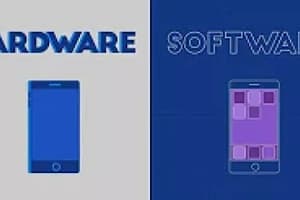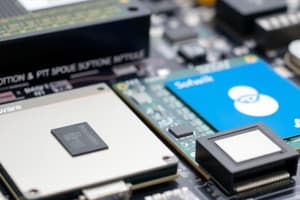Podcast
Questions and Answers
What does the term 'algorithm' refer to in computer science?
What does the term 'algorithm' refer to in computer science?
- A type of hardware used in computing devices
- A data structure used for storing information
- A step-by-step procedure for solving a problem (correct)
- A programming language used for software development
Which of the following best describes the role of the CPU in a computer system?
Which of the following best describes the role of the CPU in a computer system?
- It connects various hardware components together
- It manages the graphical display output
- It executes instructions and processes data (correct)
- It stores data permanently for future access
In programming, what is a 'variable' commonly used for?
In programming, what is a 'variable' commonly used for?
- To execute a function repeatedly
- To initialize a hardware component
- To define a constant value
- To store a value that can change (correct)
What is the purpose of an operating system in a computer?
What is the purpose of an operating system in a computer?
Which of the following best describes 'networking' in computer science?
Which of the following best describes 'networking' in computer science?
Flashcards
What are MCQs?
What are MCQs?
Multiple Choice Questions are assessment tools that present a question with multiple possible answers.
O Level Computer Science
O Level Computer Science
A secondary school-level computer science curriculum.
Computer Science MCQs
Computer Science MCQs
Multiple choice questions related to the concepts of O Levels Computer Science.
What are the MCQs for?
What are the MCQs for?
Signup and view all the flashcards
How to answer Computer science MCQs
How to answer Computer science MCQs
Signup and view all the flashcards
Study Notes
General Computer Science Concepts
- Data Representation: Binary, decimal, hexadecimal, ASCII, Unicode. Understanding how different data types (text, numbers, images) are stored in computer memory.
- Hardware Components: Processing unit (CPU), memory (RAM, ROM), storage devices (hard drives, SSDs, optical drives), input devices (keyboard, mouse, scanner), output devices (monitor, printer). Knowing the function of each and their relationships.
- Software Types: Operating systems (Windows, macOS, Linux), applications (word processors, spreadsheets, browsers), system software, programming languages. Different types of software and their uses.
- Computer Networks: Local Area Networks (LANs), Wide Area Networks (WANs), the internet, network topologies (bus, star, ring). Basic understanding of network structures and components.
- Number Systems: Conversion between binary, decimal, and hexadecimal. Fundamental arithmetic operations within different number systems.
- Data Structures: Lists, arrays, stacks, queues. Basic understanding of how data is organized.
- Algorithms: Basic sorting (bubble, insertion). Understanding steps/processes a computer follows for solving a certain task.
- Software Development Life Cycle (SDLC): Phases (analysis, design, implementation, testing, maintenance). Understanding the stages involved in creating software.
- Programming Logic: Sequencing, selection (if-then-else), iteration (loops). Basic programming concepts that govern program flow.
- Basic Operating System Features: File management (creating, deleting, copying files), directory structures. Common functions provided by an OS.
Specific O Level Topics (Example)
- Input/output devices: Identifying different input and output components, their functions, and their characteristics, such as resolution, speed, and capacity.
- Data types: Understanding different data types and their impact on storage and manipulation. This could include integers, floats, characters, booleans, and strings.
- Logic gates: Understanding functions of AND, OR, NOT, NAND, NOR, XOR, and XNOR gates. Practical examples as part of integrated circuits.
- Binary arithmetic: Converting numbers, performing addition, subtraction, multiplication, and division in binary.
- File systems: Types of file structures and methods of organizing data within a file system. e.g., folders, files.
- Operating System Functions: Understanding the roles of an operating system in managing system resources, handling processes, managing files.
Problem Solving and Programming Concepts (Example)
- Algorithms and Problem Solving: Applying problem-solving strategies to algorithms and determining the best algorithm for a given situation using pseudo code or flowcharts.
- Pseudocode and Flowcharts: Creating algorithms and representing them using pseudocode or flowcharts to understand the sequence of steps required for a solution.
- Coding Constructs: Understanding if-then-else statements, loop structures, functions, arrays, and variables relevant to the specific programming language that is part of the O Level course of study. e.g., defining variables in a language like Python, or creating conditional statements like 'if-else'.
Specific Examples of MCQ Questions (Illustrative)
- Convert the decimal 25 to its binary equivalent.
- Which device is used to capture digital images?
- What is the purpose of a compiler?
- Explain error handling in a program.
- Evaluate a piece of code to display its output.
- Describe how data is saved to memory.
- Detail how to input data through a keyboard.
- Describe the function of a RAM.
Exam Preparation Strategies (General)
- Understand concepts thoroughly: Focus on deep comprehension before memorization.
- Practice MCQs: Use past papers and practice questions to familiarize yourself with exam-style questions.
- Revise regularly: Don't cram; spaced revision is more effective.
- Identify weaknesses: Pinpoint areas where you need more practice.
- Seek clarification: Ask questions if you don't understand something.
Studying That Suits You
Use AI to generate personalized quizzes and flashcards to suit your learning preferences.
Description
Explore the fundamental concepts of general computer science, including data representation, hardware components, software types, and computer networks. This quiz also covers number systems and their conversions, providing a comprehensive overview of how computers function and communicate.




